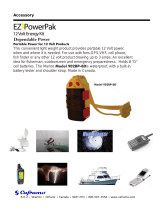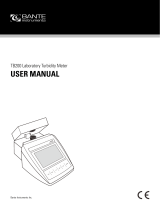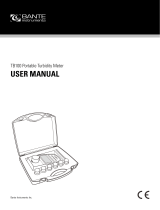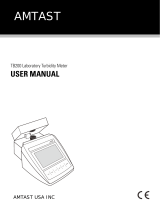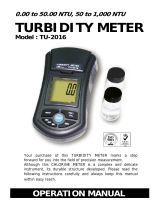Page is loading ...

CAT. NO. 46500-88
PORTABLE TURBIDIMETER
Model 2100P
Instrument and Procedure Manual
© Hach Company, 1991-2004, 2008. 4/08 9ed
All rights reserved. Printed in China.

2

3
TABLE OF CONTENTS
TABLE OF CONTENTS ................................................................ 3
CERTIFICATION............................................................................ 5
SAFETY PRECAUTIONS ............................................................. 7
SPECIFICATIONS .......................................................................... 9
OPERATION....................................................................................11
SECTION 1 DESCRIPTION....................................................... 13
1.1 General Description....................................................................... 13
1.2 Accessories .................................................................................... 14
1.3 Principle of Operation ................................................................... 14
1.4 Preparation for Use........................................................................ 15
1.4.1 Unpacking ............................................................................ 15
1.4.2 Battery Installation............................................................... 16
1.4.3 Using the Battery Eliminator and Rechargeable Batteries... 16
1.4.4 Calibration............................................................................ 16
SECTION 2 TURBIDITY MEASUREMENT ........................ 19
2.1 Operating Controls and Indicators................................................. 19
2.2 Turbidity Measurement ................................................................. 19
2.2.1 Turbidity Measurement Procedure....................................... 20
2.2.2 Measurement Notes ............................................................. 22
2.3 Measurement Techniques .............................................................. 22
2.3.1 Cleaning Sample Cells......................................................... 23
2.3.2 Oiling the Sample Cell......................................................... 23
2.3.3 Orienting Sample Cells........................................................ 24
2.3.4 Matching multiple sample cells ........................................... 26
2.3.5 Removing Bubbles (Degassing) .......................................... 28
2.3.6 Measuring Overrange Samples ............................................ 31
2.3.7 Condensation (fogging) ....................................................... 31
2.3.8 Calibration............................................................................ 31
2.3.9 Representative Sampling ..................................................... 32

4
TABLE OF CONTENTS, continued
SECTION 3 OPERATION
.......................................................... 33
3.1 Operational Controls and Indicators............................................. 33
3.2 Using the Read Key ...................................................................... 35
3.2.1 Continuous Reading ............................................................ 35
3.3 Using the Signal Averaging Key .................................................. 35
3.4 Using the Range Selection Key .................................................... 36
3.5 Restoring the Default Calibration................................................. 36
3.6 Calibration .................................................................................... 37
3.6.1 StablCal Stabilized Formazin Standards ............................. 37
3.6.2 Formazin Primary Standards ............................................... 40
3.6.3 Calibrating the Turbidimeter ............................................... 44
3.6.4 Using Gelex
®
Secondary Turbidity Standards.................... 54
MAINTENANCE............................................................................ 57
SECTION 4 MAINTENANCE................................................... 59
4.1 Cleaning........................................................................................ 59
4.2 Battery Replacement..................................................................... 59
4.3 Lamp Replacement ....................................................................... 59
SECTION 5 TROUBLESHOOTING ....................................... 67
5.1 Using the Diagnostic Functions Key ............................................ 67
5.1.1 Basic Diagnostic Codes....................................................... 67
5.2 The Diagnostic Procedure............................................................. 68
5.3 Other Instrument Diagnostics ....................................................... 70
5.3.1 Display Test......................................................................... 70
5.4 Error Messages ............................................................................. 70
5.4.1 Flashing Numeric Display................................................... 70
5.4.2 E Messages.......................................................................... 70
5.4.3 CAL? ................................................................................... 70
GENERAL INFORMATION....................................................... 73
Replacement Parts & Accessories.............................................. 74
HOW TO ORDER ......................................................................... 76
REPAIR SERVICE........................................................................ 77
WARRANTY................................................................................... 78

5
CERTIFICATION
Hach Company certifies this instrument was tested thoroughly,
inspected and found to meet its published specifications when it was
shipped from the factory.
The Model 2100P Portable Turbidimeter has been tested and is certified
as indicated to the following instrumentation standards:
Product Safety
Battery/Eliminator Power Supply Only:
120 Vac, 60 Hz, UL Listed & CSA Certified, Class 2
230 Vac, 50 Hz, VDE Approved, GS & CE marked
Immunity
2100P Turbidimeter Tested with external Battery/Eliminator
Power Supply:
EN 50082-1 (European Generic Immunity Standard) per 89/336/EEC
EMC: Supporting test records with Dash Straus and Goodhue, Inc.
(now Intertek Testing Services), certified compliance by
Hach Company.
Standards include:
IEC 801-2 Electro-Static Discharge
IEC 801-3 Radiated RF Electro-Magnetic Fields
IEC 801-4 Electrical Fast Transients/Burst
Emissions
2100P Turbidimeter Tested with external Battery/Eliminator
Power Supply:
EN 50081-1 (Emissions) per 89/336/EEC EMC: Supporting test
records by Amador Corp. (now TUV Product Services), certified
compliance by Hach Company
Standards include:
EN 55022 (CISPR 22) Emissions, Class B Limits
Canadian Radio Interference-Causing Regulation, Chapter 1374,
Class A: Supporting test records by Amador Corp. (now TUV Product
Services), certified compliance by Hach Company
This Class A digital apparatus meets all requirements of the Canadian
Interference-Causing Equipment Regulations.
Cet appareil numérique de la classe A respecte toutes les exigences du
Règlement sur le matériel brouilleur du Canada.

6
CERTIFICATION, continued
FCC Part 15, Class “A” Limits: Supporting test records by Amador
Corp. (now TUV Product Services), certified compliance by
Hach Company.
This device complies with Part 15 of the FCC Rules. Operation is
subject to the following two conditions:
1. this device may not cause harmful interference, and
2. this device must accept any interference received, including
interference that may cause undesired operation.
Changes or modifications to this unit not expressly approved by the
party responsible for compliance could void the user’s authority to
operate the equipment.
This equipment has been tested and found to comply with the limits
for a Class A digital device, pursuant to Part 15 of the FCC Rules.
These limits are designed to provide reasonable protection against
harmful interference when the equipment is operated in a commercial
environment. This equipment generates, uses, and can radiate radio
frequency energy and, if not installed and used in accordance with
the instruction manual, may cause harmful interference to radio
communications. Operation of this equipment in a residential area may
cause harmful interference in which case the user will be required to
correct the interference at his own expense.
The following techniques of reducing interference problems are
applied easily:
1. Disconnect the battery eliminator from it’s power source and
from the 2100P Portable Turbidimeter to verify if it is the source
of the interference
2. If the battery eliminator for the 2100P Portable Turbidimeter is
plugged into the same outlet as the device with which it is
interfering, try another outlet.
3. Move the 2100P Portable Turbidimeter away from the device
receiving the interference.
4. Reposition the receiving antenna for the device receiving
the interference.
5. Try combinations of the above.

7
SAFETY PRECAUTIONS
Please read this entire manual before unpacking, setting up, or
operating this instrument. Pay particular attention to all danger and
caution statements. Failure to do so could result in serious injury to the
operator or damage to the equipment.
To ensure the protection provided by this equipment is not impaired, do
not use or install this equipment in any manner other than that which is
specified in this manual.
Use of Hazard Information
If multiple hazards exist, this manual will use the signal word (Danger,
Caution, Note) corresponding to the greatest hazard.
DANGER
Indicates a potentially or imminently hazardous situation which,
if not avoided, could result in death or serious injury.
CAUTION
Indicates a potentially hazardous situation that may result in minor
or moderate injury.
NOTE
Information that requires special emphasis.
Precautionary Labels
Read all labels and tags attached to the instrument. Personal injury or
damage to the instrument could occur if not observed.
This symbol, if noted on the instrument, references the instruction
manual for operational and/or safety information.

8

9
SPECIFICATIONS
Specifications subject to change without notice.
Operating specifications applicable at 25 °C unless noted.
Program software copyrighted by Hach Company, 1991.
Measurement Method: Ratio Nephelometric signal (90°) scatter light
ratio to transmitted light
Range: 0-1000 NTU with automatic decimal point placement or
manual range selection of 0-9.99, 0-99.9 and 0-1000 NTU
Accuracy: ± 2% of reading plus stray light from 0-1000 NTU
Resolution: 0.01 NTU on lowest range
Repeatability: ±1% of reading or 0.01 NTU, whichever is greater (with
Gelex standards)
Response Time: 6 seconds for full step change without signal
averaging in constant reading mode
Stray Light: <0.02 NTU
Standardization: StablCal
®
Stabilized Formazin primary standards or
Formazin primary standards
Secondary Standards: Gelex
®
Secondary Standards
Display: Four-digit liquid crystal; 10.16 mm (0.4 in) high digits with
custom icons
Light Source: Tungsten filament lamp; lamp life typically greater than
100,000 readings
Detectors: Silicon photovoltaic
Signal Averaging: Operator selectable on or off
Sample Cells: (Height X width) 60.0 X 25 mm (2.36 X 1 in)
Borosilicate glass with screw caps, marking band and fill line
Sample Required: 15 mL (0.5 oz.)
Storage Temperature: -40 to 60 °C (-40 to 140 °F) (instrument only)

10
SPECIFICATIONS, continued
Operating Temperature: 0 to 50 °C (32 to 122 °F) (instrument only)
Operating Humidity Range: 0 to 90% RH noncondensing at 30 °C;
0 to 80% RH noncondensing at 40 °C;
0 to 70% RH noncondensing at 50 °C
Power Requirements: Four AA Alkaline cells or optional
battery eliminator
Battery Life: Typically 300 tests with signal average mode off;
180 tests with signal average mode on
Battery Eliminator (optional):
For 120 V eliminator: CSA and UL approved for 120 VAC ±10%,
60 Hz, 6 V at 800 mA DC output
For 230 V eliminator: CE (VDE) approval pending for 230 VAC
±10%, 50 Hz, 6 V at 900 mA DC output
Enclosure: High impact ABS plastic
Dimensions: 22.2 X 9.5 X 7.9 cm (8.75 X 3.75 X 3.12 in)
Instrument Weight: 520 kg (1 lb 2.5 oz)
Shipping Weight: 3.1 kg (6 lbs 8.5 oz)

DANGER
Handling chemical samples, standards, and reagents can be dangerous.
Review the necessary Material Safety Data Sheets and become familiar with
all safety procedures before handling any chemicals.
DANGER
La manipulation des échantillons chimiques, étalons et réactifs peut être
dangereuse. Lire les Fiches de Données de Sécurité des Produits (FDSP) et
se familiariser avec toutes les procédures de sécurité avant de manipuler tous
les produits chimiques.
PELIGRO
La manipulación de muestras químicas, estándares y reactivos puede ser
peligrosa. Revise las fichas de seguridad de materiales y familiarícese con
los procedimientos de seguridad antes de manipular productos químicos.
GEFAHR
Das Arbeiten mit chemischen Proben, Standards und Reagenzien ist mit
Gefahren verbunden. Es wird dem Benutzer dieser Produkte empfohlen, sich
vor der Arbeit mit sicheren Verfahrensweisen und dem richtigen Gebrauch
der Chemikalien vertraut zu machen und alle entsprechenden
Materialsicherheitsdatenblätter aufmerksam zu lesen.
PERIGO
A manipulação de amostras, padrões e reagentes químicos pode ser perigosa.
Reveja a folha dos dados de segurança do material e familiarize-se com
todos os procedimentos de segurança antes de manipular quaisquer produtos
químicos.
PERICOLO
La manipolazione di campioni, standard e reattivi chimici può essere
pericolosa. La preghiamo di prendere conoscenza delle Schede Techniche
necessarie legate alla Sicurezza dei Materiali e di abituarsi con tutte
le procedure di sicurezza prima di manipolare ogni prodotto chimico.
11
OPERATION

12

13
SECTION 1 DESCRIPTION
1.1 General Description
The Hach Model 2100P Portable Turbidimeter (Figure 1) measures
turbidity from 0.01 to 1000 NTU in automatic range mode with
automatic decimal point placement. The manual range mode measures
turbidity in three ranges: 0.01 to 9.99, 10 to 99.9 and 100 to 1000 NTU.
Designed primarily for field use, the microprocessor-based Model
2100P has the range, accuracy, and resolution of many laboratory
instruments. The instrument operates on four AA batteries or with an
optional battery eliminator. Rechargeable nickel-cadmium cells may
be used, but cannot be recharged in the instrument. The instrument
automatically shuts off after 5.5 minutes if no keystrokes occur
(does not influence operation). If this occurs, simply turn the instrument
on – the 2100P will resume operation as if the power had not been
interrupted. The instrument, all standard accessories, and the optional
battery eliminator may be conveniently stored in the carrying case.
Figure 1 2100P Turbidimeter and Accessories
Note: Avoid prolonged exposure to ultraviolet light and sunlight.
Note: Do not hold the instrument during measurements; place the instrument on a flat,
steady surface.

14
SECTION 1, continued
1.2 Accessories
Accessories supplied with the turbidimeter include nine sample
cells; three Gelex
®
Secondary Standards (included with 4650000 only);
one sealed vial each of:
<0.1-NTU, 20-NTU, 100-NTU, and 800-NTU StablCal
®
Stabilized
Formazin Standards; 4 AA alkaline batteries; 15 mL of silicone oil;
oiling cloth; carrying case; instrument manual; and quick reference card.
1.3 Principle of Operation
The Model 2100P Portable Turbidimeter operates on the nephelometric
principle of turbidity measurement. This instrument meets the design
criteria specified by the United States Environmental Protection
Agency, Method 180.1.
The optical system* (Figure 2) includes a tungsten-filament lamp, a 90°
detector to monitor scattered light and a transmitted light detector. The
instrument's microprocessor calculates the ratio of the signals from the
90q and transmitted light detectors. This ratio technique corrects for
interferences from color and/or light absorbing materials (such as
activated carbon) and compensates for fluctuations in lamp intensity,
providing long-term calibration stability. The optical design also
minimizes stray light, increasing measurement accuracy.
Figure 2 Ratio Optical System
* Patent number 4,198,161; other patents pending.
Lamp
Transmitted
Light
Detector
90°
Detector
Sample
Cell
Lens

15
SECTION 1, continued
1.4 Preparation for Use
1.4.1 Unpacking
Remove the instrument and accessories from the shipping box and
inspect them for damage that may have occurred due to rough handling
or extreme weather conditions. Verify the following are present:
• Model 2100P Portable Turbidimeter
• Instrument Manual (with quick reference card)
• Set of StablCal Primary Standards in sealed vials, one each of:
<0.1 NTU*
20 NTU
100 NTU
800 NTU
• Standardization Kit containing Gelex Secondary Standards
(0-10, 0-100 and 0-1000 ranges) (included with 4650000 only) plus
nine sample cells with caps.
• Silicone Oil, 15-mL (0.5 oz) dropping bottle
• Oiling Cloth
• Carrying Case
• Four AA alkaline batteries
If any of the items are missing or damaged, please contact the Customer
Service Department, Hach Company, Loveland, Colorado. The toll-free
number in the United States is 800-227-4224. International customers
should contact the Hach office or authorized distributor serving your
area. Refer to REPAIR SERVICE on page 77. Please do not return the
instrument without prior authorization from Hach.
* Used in place of the dilution water standard when performing a
calibration.

16
SECTION 1, continued
1.4.2 Battery Installation
The instrument is shipped completely assembled without the batteries
installed. Before use, install the four AA alkaline batteries or connect
the battery eliminator (Figure 3). For battery operation, remove the
battery compartment cover on the instrument bottom and install the
batteries. Correct battery polarity is shown on the battery holder. The
instrument will not function if the batteries are not installed correctly.
Reinstall the battery compartment cover.
Figure 3 Battery Installation
1.4.3 Using the Battery Eliminator and
Rechargeable Batteries
For operation with the optional battery eliminator, plug the eliminator
jack into the connector on the turbidimeter side. The battery eliminator
may be used with or without the batteries installed. The eliminator will
not charge batteries. Rechargeable batteries may be used in the
instrument, but must be removed for recharging. See HOW TO ORDER
on page 76 for ordering information. To prolong battery life,
the instrument lamp turns on temporarily when the
READ key
is depressed. Batteries are not necessary for battery
eliminator operation.
1.4.4 Calibration
The 2100P Portable Turbidimeter is calibrated with Formazin Primary
Standard at the factory. However, the instrument should be calibrated
upon receipt for best results. Hach recommends recalibration with

17
SECTION 1, continued
formazin once every three months, or more often as experience dictates.
The Gelex Secondary Standards supplied with the instrument (included
with 4650000 only) are labelled with general ranges for application, but
must be assigned values before use from formazin calibration. See
Section 3.6 on page 37 for calibration instructions.

18

19
SECTION 2 TURBIDITY MEASUREMENT
2.1 Operating Controls and Indicators
Figure 4 shows the 2100P controls and indicators. Refer to SECTION 3
for a detailed description of each control and indicator.
Figure 4 Keyboard and Display with Descriptions
2.2 Turbidity Measurement
Measurements may be made with the signal average mode on or off and
in manual or automatic range selection mode. Using automatic range
selection is recommended. Signal averaging uses more power and
should be used only when the sample causes an unstable reading. Signal
averaging measures and averages ten measurements while displaying
2100P TURBIDIMETER
EDIT
DIAG
NTU
CAL?
POWER
MODE
CAL
DIAG
SIGNAL
AVERAGE
AUTO RNG SIG AVG
RANGE
READ
Indicates instrument is
in calibration mode
Indicates
recalibration may
be necessary
Indicates
measurement unit
is Nephelometric
Turbidity Unit
Displayed when
Signal Averaging
is on
Displayed when
instrument is in
automatic range
mode
Used to scroll
through diagnostic
and calibration
modes. Also scrolls
through numbers.
Turns signal
averaging function
on and off
Power switch to
turn instrument
on and off
Used to access and
exit calibration mode
Used to edit displayed
values and display
lamp-on values in
diagnostic mode
Constant display
indicates lamp is on;
flashing indicates
low light level
Flashes when battery
voltage level drops
below 4.4 volts
Negative sign for
some diagnostic values
Prompting indicator for
calibration sequence
Displayed when instrument
is in diagnostic mode
Four digit display
Indicates which
standard should be
measured when “S” is
displayed, and which
diagnostic code is
functional when
“DIAG” is displayed
Used to access and exit
diagnostic mode
Pressed to start measurement
Selects auto range or one of
three manual range modes

20
SECTION 2, continued
intermediate results. The initial value is displayed after about
11 seconds and the display is updated every 1.2 seconds until all ten
measurements are taken (about 20 seconds). After this, the lamp turns
off, but the final measured turbidity value continues to be displayed
until another key is pressed.
When not in signal average mode, the final value is displayed after
about 13 seconds.
Accurate turbidity measurement depends on good measurement
technique by the analyst, such as using clean sample cells in
good condition and removing air bubbles (degassing).
Refer to Section 2.3 on page 22 for a detailed discussion
of measurement techniques.
2.2.1 Turbidity Measurement Procedure
1.
Collect a representa-
tive sample in a clean
container. Fill a sample
cell to the line (about
15 mL), taking care to
handle the sample cell by
the top. Cap the cell. (See
Section 2.3 on page 22
for more information
about collecting a
representative sample).
Note: The instrument auto-
matically shuts off after
5.5 minutes if no keystrokes
occur. To resume operation,
press
I/O.
2. Wipe the cell with
a soft, lint-free cloth to
remove water spots and
fingerprints.
3. Apply a thin film of
silicone oil. Wipe with a
soft cloth to obtain an
even film over the entire
surface.
/







